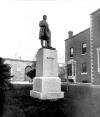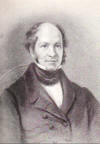 William Dargan, the son of
Patrick Dargan, a farmer, was born in Killeshin in the county of
Laois on 28 February 1799. Dargan is the eldest in a large family of
tenant farmers on the Earl of Portarlington‘s estate. He attends a local hedge
school in Graiguecullen near Carlow, where he excels in mathematics and
accounting. He subsequently works on his father’s 101-acre farm before securing
a position in a surveyor’s office in Carlow. With the assistance of prominent
local people, particularly John Alexander, a prominent Carlow miller, and Henry
Parnell MP for County Laois, he begins working with the Scottish engineer Thomas
Telford on the Holyhead side of the London-Holyhead road. He works there between
1819 and 1824.
William Dargan, the son of
Patrick Dargan, a farmer, was born in Killeshin in the county of
Laois on 28 February 1799. Dargan is the eldest in a large family of
tenant farmers on the Earl of Portarlington‘s estate. He attends a local hedge
school in Graiguecullen near Carlow, where he excels in mathematics and
accounting. He subsequently works on his father’s 101-acre farm before securing
a position in a surveyor’s office in Carlow. With the assistance of prominent
local people, particularly John Alexander, a prominent Carlow miller, and Henry
Parnell MP for County Laois, he begins working with the Scottish engineer Thomas
Telford on the Holyhead side of the London-Holyhead road. He works there between
1819 and 1824.
Having become qualified in his
chosen profession, working in a Dublin Surveyors office,
Dargan went on to work in England. He was involved with
George Stephenson's pioneering "Rocket" project and the
construction of the London-Holyhead rail link lead by the
great English engineer Thomas Telford.
The first important employment he obtained was under Thomas Telford in
constructing the Holyhead road in 1820; when that work was finished he returned
to Ireland and took small contracts on his own account, the most important of
which was the road from Dublin to Howth.
When Dargan returned to Ireland,
he obtained several small contracts on his own account. It
was in 1834 that Dargan became contractor of the first
railway in Ireland. This was the Dublin to Kingstown line.
In 1846 proposals were made for
the construction of a second line to serve south Dublin.
Dargan was again appointed engineer for this project. What
finally materialised was the "Harcourt Street" line which
opened on the 10th July, 1854, running from Dublin to Bray.
It initially served stations at Dundrum, Stillorgan,
Carrickmines and Shankill.
Dargan had many difficulties to
contend with whilst building the line, including the major
engineering problem of passing through a spur in the Dublin
mountains. He solved this problem by making deep and
difficult cutting into the spur. He was not only involved in
the engineering of the line, but was also involved in the
design of many of the line's stations. It is therefore not
surprising to learn that Dundrum station, situated near to
Dargan's estate at Mount Anville, was better designed and
more comfortable than the other stations on the line. In the
years following, Dargan was a regular commuter from the
station!
 In an effort to draw attention
to railways and their benefits to industry, Dargan organised
and sponsored the Dublin Industrial Exhibition which took
place at the Royal Dublin Society, Ballsbridge in 1853. This
exhibition was officially opened by Queen Victoria. The
royal party, which included Prince Albert and the Prince of
Wales also paid a visit Dargan's estate at Mount Anville,
Goatstown. It is understood that the Queen wished to confer
a knighthood on Mr. Dargan in honour of his great
contribution to engineering and railways. He declined the
offer, however.
In an effort to draw attention
to railways and their benefits to industry, Dargan organised
and sponsored the Dublin Industrial Exhibition which took
place at the Royal Dublin Society, Ballsbridge in 1853. This
exhibition was officially opened by Queen Victoria. The
royal party, which included Prince Albert and the Prince of
Wales also paid a visit Dargan's estate at Mount Anville,
Goatstown. It is understood that the Queen wished to confer
a knighthood on Mr. Dargan in honour of his great
contribution to engineering and railways. He declined the
offer, however.
Around this time, Dargan, who
was one of Ireland's richest men, made a generous donation
of £40,000 which led to the setting up of the National
Gallery of Ireland. A statue to commemorate him can still be
seen today in front of the gallery.
He will be remembered for his
friendship with the royal family but more importantly, for
his reputation as railway engineer.
In 1866 he was injured in a
horse riding accident. He died at the age of 68 and is
buried at Glasnevin Cemetery.
Quotes by William Dargan
A spoonful of honey
will catch more flies than a gallon of vinegar. ~ William
Dargan, Quoted in Seventy Years of Irish Life (1896).
Never show your teeth
unless you can bite. ~ William Dargan, Quoted in Seventy
Years of Irish Life (1896).
-

- Memorial plaque to William Dargan
1799-1867.
- Famous Engineer and builder of Irish
Railways. Promoter of the Great Exhibition of 1853.
- Born near Carlow Town.
- Known for his generosity as; "The man with
his hand in his pocket"
- Erected by the Old Carlow Society on
Heritage Day 12th Sept. 1993.
|
Luas Bridge at Taney Junction
by Tom Manning
July 2004
The award-winning cable-stay Luas bridge
at Taney Junction was named
“The William Dargan Bridge” on
Monday July 19th by Fr. Daniel Dargan S.J. in the presence
of the Minister for Transport, Mr. Seamus Brennan T.D.
Fr.Dargan is a direct descendant of William Dargan
(1799-1867) who is widely regarded as the father of Irish
railways. Dargan was responsible for building the Harcourt
Street Line which has now become the Luas Green Line. He
lived nearby at Mount Anville and was a regular user of
Dundrum Station. RPA accepted the recommendation of the
selection committee - which was chaired by RPA Chief
Architect Jim Quinlan - that naming the new bridge in honour
of William Dargan would be a fitting tribute to the memory
of a pioneer of public transport in Ireland. RPA Chief
Executive, Frank Allen thanked all those who had contributed
to the selection process and said that he was very proud
that this giant of the Irish rail tradition would have a
suitable monument to his memory in his home area of Dundrum.
“I am particularly pleased that Fr. Daniel Dargan is here to
open the bridge in the presence of the Minister of
Transport”, said Mr. Allen.
Written by Tom Manning
- The information contained in these
pages is provided solely for the purpose of sharing with others
researching their ancestors in Ireland.
- © 2001 Ireland Genealogy Projects,
IGP TM By
Pre-emptive Copyright - All rights reserved
TOP OF PAGE